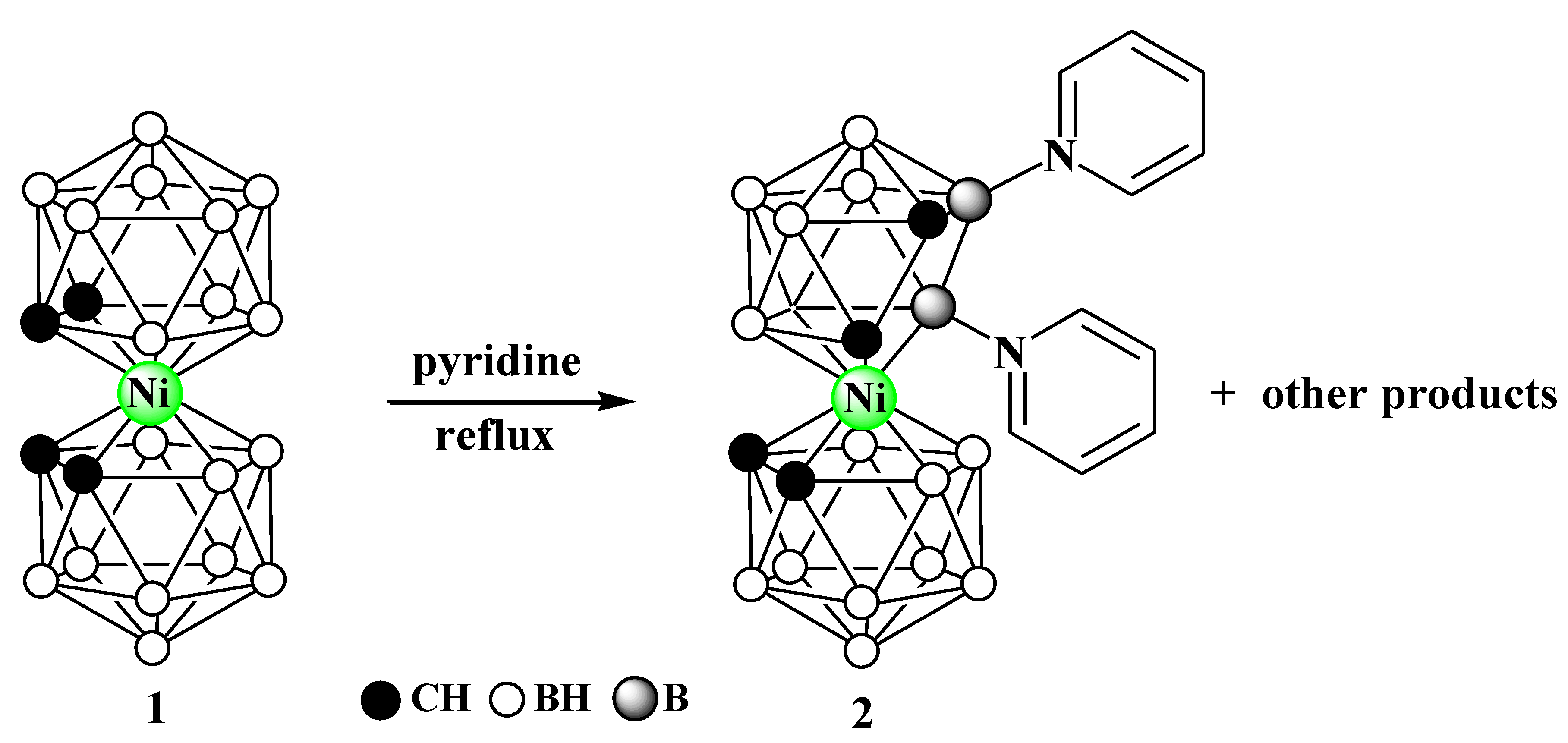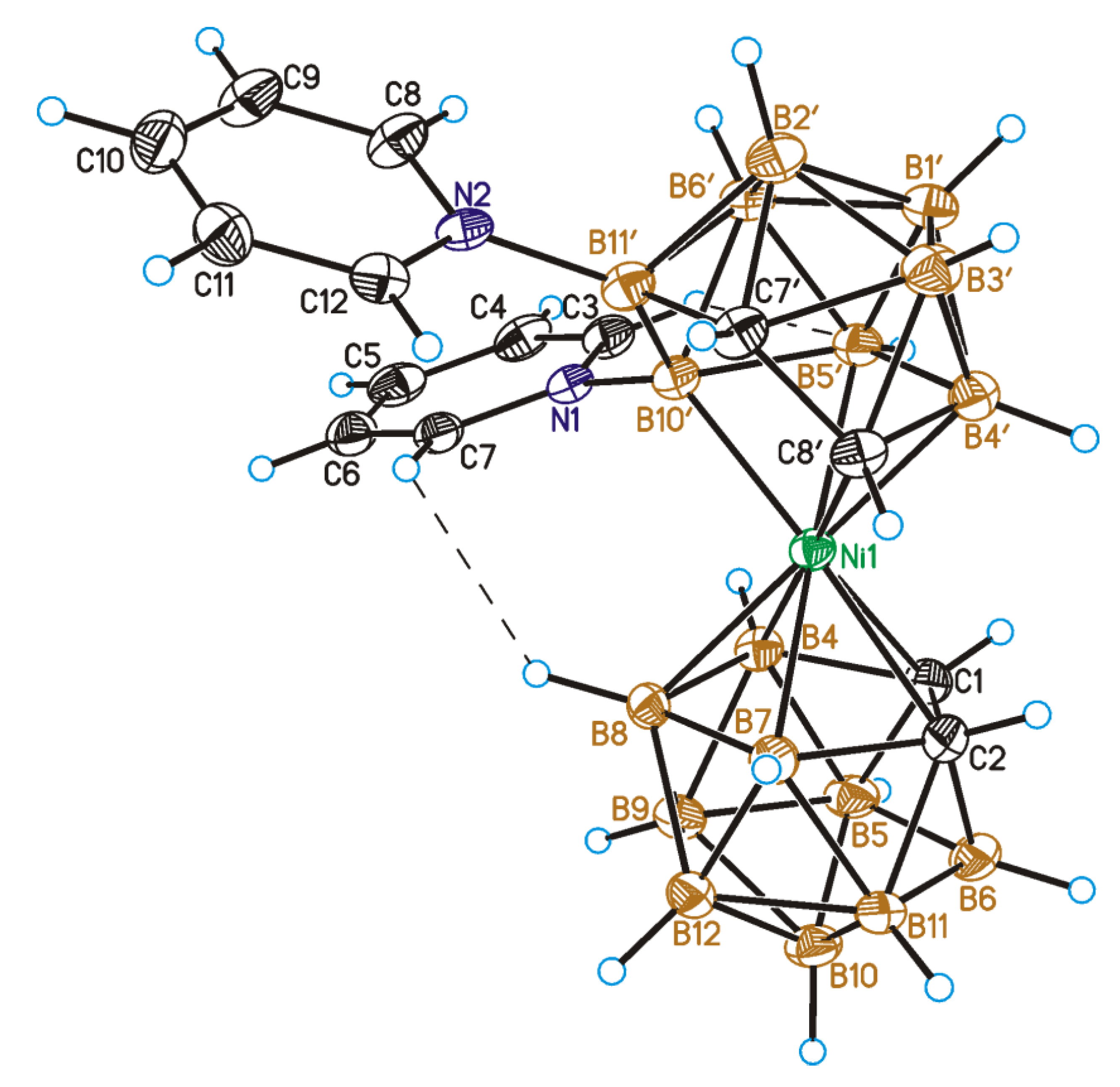The First Nickelacarborane with closo-nido Structure
Abstract
1. Introduction
2. Results and Discussion
3. Materials and Methods
3.1. General Methods
3.2. Reaction of Nickel(IV) Bis(Dicarbollide) with Pyridine
Supplementary Materials
Author Contributions
Funding
Acknowledgments
Conflicts of Interest
References
- Grimes, R.N. Transition metal metallacarbaboranes. In Comprehensive Organometallic Chemistry II, Volume 1; Housecraft, C.E., Ed.; Pergamon Press: Oxford, UK, 1995; pp. 373–430. [Google Scholar] [CrossRef]
- Hosmane, N.S.; Maguire, J.A. Metallacarboranes of d- and ƒ-block metals. In Comprehensive Organometallic Chemistry III, Volume 3; Housecraft, C.E., Ed.; Elsevier Science: Amsterdam, The Netherlands, 2007; pp. 175–264. [Google Scholar] [CrossRef]
- Grimes, R.N. Carboranes, 3rd ed.; Academic Press: London, UK, 2016; pp. 711–903. [Google Scholar] [CrossRef]
- Sivaev, I.B.; Bregadze, V.I. Chemistry of nickel and iron bis(dicarbollides). A review. J. Organomet. Chem. 2000, 614–615, 27–36. [Google Scholar] [CrossRef]
- Hawthorne, M.F.; Zink, J.I.; Skelton, J.M.; Bayer, M.J.; Liu, C.; Livshits, E.; Baer, R.; Neuhauser, D. Electrical or photocontrol of the rotary motion of a metallacarborane. Science 2004, 303, 1849–1851. [Google Scholar] [CrossRef]
- Safronov, A.V.; Shlyakhtina, N.I.; Everett, T.A.; VanGordon, M.R.; Sevryugina, Y.V.; Jalisatgi, S.S.; Hawthorne, M.F. Direct observation of bis(dicarbollyl)nickel conformers in solution by fluorescence spectroscopy: An approach to redox-controlled metallacarborane molecular motors. Inorg. Chem. 2014, 53, 10045–10053. [Google Scholar] [CrossRef] [PubMed]
- Shlyakhtina, N.I.; Safronov, A.V.; Sevryugina, Y.V.; Jalisatgi, S.S.; Hawthorne, M.F. Synthesis, characterization, and preliminary fluorescence study of a mixed-ligand bis(dicarbollyl)nickel complex bearing a tryptophan-BODIPY FRET couple. J. Organomet. Chem. 2015, 798, 234–244. [Google Scholar] [CrossRef]
- Anufriev, S.A.; Suponitsky, K.Y.; Filippov, O.A.; Sivaev, I.B. Synthesis and structure of methylsulfanyl derivatives of nickel bis(dicarbollide). Molecules 2019, 24, 4449. [Google Scholar] [CrossRef]
- Spokoyny, A.M.; Li, T.C.; Farha, O.K.; Machan, C.W.; She, C.; Stern, C.L.; Marks, T.J.; Hupp, J.T.; Mirkin, C.A. Electronic tuning of nickel-based bis(dicarbollide) redox shuttles in dye-sensitized solar cells. Angew. Chem. Int. Ed. 2010, 49, 5339–5343. [Google Scholar] [CrossRef]
- Li, T.C.; Spokoyny, A.M.; She, C.; Farha, O.K.; Mirkin, C.A.; Marks, T.J.; Hupp, J.T. Ni(III)/(IV) bis(dicarbollide) as a fast, noncorrosive redox shuttle for dye-sensitized solar cells. J. Am. Chem. Soc. 2010, 132, 4580–4582. [Google Scholar] [CrossRef]
- Kung, C.-W.; Otake, K.; Buru, C.T.; Goswami, S.; Cui, Y.; Hupp, J.T.; Spokoyny, A.M.; Farha, O.K. Increased electrical conductivity in a mesoporous metal-organic framework featuring metallacarboranes guests. J. Am. Chem. Soc. 2018, 140, 3871–3875. [Google Scholar] [CrossRef]
- Warren, L.F.; Hawthorne, M.F. Chemistry of the bis[π-(3)-1,2-dicarbollyl] metalates of nickel and palladium. J. Am. Chem. Soc. 1970, 92, 1157–1173. [Google Scholar] [CrossRef]
- Maier, N.A.; Erdman, A.A.; Zubreichuk, Z.P.; Prokopovich, V.P.; Ol’dekop, Y.A. Synthesis and some transformations of complex nickel(II) salts of bis(3,1,2-dicarbollyl)nickel(III). Preparation of 3-(2,2′- bipyridyl)-closo-3,1,2-nickeladicarbadodecaborane. J. Organomet. Chem. 1985, 292, 297–302. [Google Scholar] [CrossRef]
- Zubreichuk, Z.P.; Erdman, A.A.; Ivko, A.A.; Maier, N.A. Synthesis and some transformations of complex salts of bis-o-dicarbollyliron(II), -cobalt(II), and -nickel(II). Russ. J. Gen. Chem. 2001, 71, 531–534. [Google Scholar] [CrossRef]
- Erdman, A.A.; Zubreichuk, Z.P.; Knizhnikov, V.A.; Maier, A.A.; Aleksandrov, G.G.; Nefedov, S.E.; Eremenko, I.L. Synthesis and the structure of the triphenylphosphine complex of o-nickelacarborane, 3,3-(PPh3)2-3,1,2-NiC2B9H11. Russ. Chem. Bull. 2001, 50, 2248–2250. [Google Scholar] [CrossRef]
- Andreichuk, E.P.; Anisimov, A.A.; Shmalko, A.V.; Suponitsky, K.Y.; Sivaev, I.B.; Bregadze, V.I. Stability of nickel bis(dicarbollide) complexes. Mendeleev Commun. 2019, 29, 534–536. [Google Scholar] [CrossRef]
- Viñas, C.; Pedrajas, J.; Teixidor, T.; Kivekäs, R.; Sillanpää, R.; Welch, A.J. First example of a bis(dicarbollide) metallacarborane containing a B,C‘-heteronuclear bridge. Inorg. Chem. 1997, 36, 2988–2991. [Google Scholar] [CrossRef] [PubMed]
- Planas, J.G.; Viñas, C.; Teixidor, F.; Light, M.E.; Hursthouse, M.B. A boron-boron linked large metallacarborane cluster: Characterization and X-ray structure of 8,9′-[closo-{3-Co(η5-C5H5)-1,2-C2B9H10}]2. J. Organomet. Chem. 2006, 691, 3472–3476. [Google Scholar] [CrossRef]
- Molotkov, A.P.; Vinogradov, M.M.; Moskovets, A.P.; Chusova, O.; Timofeev, S.V.; Fastovskiy, V.A.; Nelyubina, Y.V.; Pavlov, A.A.; Chusov, D.A.; Loginov, D.A. Iridium halide complexes [1,1-X2-8-SMe2-1,2,8-IrC2B9H10]2 (X = Cl, Br, I): Synthesis, reactivity and catalytic activity. Eur. J. Inorg. Chem. 2017, 4635–4644. [Google Scholar] [CrossRef]
- Jeans, R.J.; Chan, A.P.Y.; Riley, L.E.; Taylor, J.; Rosair, G.M.; Welch, A.J.; Sivaev, I.B. Arene-ruthenium complexes of 1,1′-bis(ortho-carborane): Synthesis, characterization, and catalysis. Inorg. Chem. 2019, 58, 11751–11761. [Google Scholar] [CrossRef]
- Chan, A.P.Y.; Parkinson, J.A.; Rosair, G.M.; Welch, A.J. Bis(phosphine)hydridorhodacarborane derivatives of 1,1′-bis(ortho-carborane) and their catalysis of alkene isomerization and the hydrosilylation of acetophenone. Inorg. Chem. 2020, 59, 2011–2023. [Google Scholar] [CrossRef]
- Chan, A.P.Y.; Rosair, G.M.; Welch, A.J. Exopolyhedral ligand orientation controls diastereoisomer in mixed-metal bis(carboranes). Molecules 2020, 25, 519. [Google Scholar] [CrossRef]
- Churchill, M.R.; Gold, K. Geometry of the (B8C2H10·C5H5N2−) anion from an X-ray structural analysis of [Et4N+][(B9C2H11)Co(B8C2H10·C5H5N)−]. J. Chem. Soc. Chem. Commun. 1972, 901–902. [Google Scholar] [CrossRef]
- Meshcheryakov, V.I.; Kitaev, P.S.; Lyssenko, K.A.; Starikova, Z.A.; Petrovskii, P.V.; Janoušek, Z.; Corsini, M.; Laschi, F.; Zanello, P.; Kudinov, A.R. (Tetramethylcyclobutadiene)cobalt complexes with monoanionic carborane ligands [9-L-7,8-C2B9H10]− (L = SMe2, NMe3 and py). J. Organomet. Chem. 2005, 690, 4745–4754. [Google Scholar] [CrossRef]
- Buades, A.B.; Arderiu, V.S.; Olid-Britos, D.; Viñas, C.; Sillanpää, R.; Haukka, M.; Fontrodona, X.; Paradinas, M.; Ocal, C.; Teixidor, F. Electron accumulative molecules. J. Am. Chem. Soc. 2018, 140, 2957–2970. [Google Scholar] [CrossRef] [PubMed]
- Bader, R.F.W. Atoms in Molecules. A Quantum Theory; Clarendon Press: Oxford, UK, 1990. [Google Scholar]
- Keith, T.A. AIMAll (Version 15.05.18); TK Gristmill Software: Overland Park, KS, USA, 2015. [Google Scholar]
- Espinosa, E.; Molins, E.; Lecomte, C. Hydrogen bond strengths revealed by topological analyses of experimentally observed electron densities. Chem. Phys. Lett. 1998, 285, 170–173. [Google Scholar] [CrossRef]
- Anufriev, S.A.; Sivaev, I.B.; Suponitsky, K.Y.; Godovikov, I.A.; Bregadze, V.I. Synthesis of 10-methylsulfide and 10-alkylmethylsulfonium nido-carborane derivatives: B-H⋯π Interactions between the B-H-B hydrogen atom and alkyne group in 10-RC≡CCH2S(Me)-7,8-C2B9H11. Eur. J. Inorg. Chem. 2017, 4436–4443. [Google Scholar] [CrossRef]
- Dmitrienko, A.O.; Karnoukhova, V.A.; Potemkin, A.A.; Struchkova, M.I.; Kryazhevskikh, I.A.; Suponitsky, K.Y. The influence of halogen type on structural features of compounds containing α-halo-α,α-dinitroethyl moieties. Chem. Heterocycl. Comp. 2017, 53, 532–539. [Google Scholar] [CrossRef]
- Sheremetev, A.B.; Aleksandrova, N.S.; Semyakin, S.S.; Suponitsky, K.Y.; Lempert, D.B. Synthesis and characterization of 3-(5-(Fluorodinitromethyl)-1H-1,2,4-triazol-3-yl)-4-nitrofurazan: A novel promising energetic component of boron-based fuels for rocket ramjet engines. Chem. Asian J. 2019, 14, 4255–4261. [Google Scholar] [CrossRef] [PubMed]
- Taoda, Y.; Sawabe, T.; Endo, Y.; Yamaguchi, K.; Fujii, S.; Kagechika, H. Identification of an intermediate in the deboronation of ortho-carborane: An adduct of ortho-carborane with two nucleophiles on one boron atom. Chem. Commun. 2008, 2049–2051. [Google Scholar] [CrossRef]
- Jones, C.J.; Francis, J.N.; Hawthorne, M.F. New 10- and 11-atom polyhedral metallocarboranes prepared by polyhedral contraction. J. Am. Chem. Soc. 1972, 94, 8391–8399. [Google Scholar] [CrossRef]
- Jones, C.J.; Francis, J.N.; Hawthorne, M.F. Derivative chemistry of metallocarboranes. nido 11-Atom metallocarboranes and their Lewis base adducts. J. Am. Chem. Soc. 1973, 95, 7633–7643. [Google Scholar] [CrossRef]
- Pisareva, I.V.; Dolgushin, F.M.; Tok, O.L.; Konoplev, V.E.; Suponitsky, K.Y.; Yanovsky, A.I.; Chizhevsky, I.T. Small metallacarborane closo-C2B4H6Ru(PPh3)2HCl formed from nido-5,6-C2B8H12 by ruthenium- mediated polyhedral contraction. Organometallics 2001, 20, 4216–4220. [Google Scholar] [CrossRef]
- Konoplev, V.E.; Tachaev, M.V.; Ulyukina, E.A. “Polyhedral contraction” of tetramethylammonium closo-carboundecaborate underaction of tris(triphenylphosphine)ruthenium dichloride. Izv. Vyssh. Uchebn. Zaved. Khim. Khim. Tekhnol. 2020, 63, 26–32. [Google Scholar] [CrossRef]
- Hawthorne, M.F.; Young, D.C.; Andrews, T.D.; Howe, D.V.; Pilling, R.L.; Pitts, A.D.; Reintjes, M.; Warren, L.F.; Wegner, P.A. π-Dicarbollyl derivatives of the transition metals. Metallocene analogs. J. Am. Chem. Soc. 1968, 90, 879–896. [Google Scholar] [CrossRef]
- APEX2 and SAINT; Bruker AXS Inc.: Madison, WI, USA, 2014.
- Sheldrick, G.M. Crystal structure refinement with SHELXL. Acta Cryst. C 2015, 71, 3–8. [Google Scholar] [CrossRef] [PubMed]


Publisher’s Note: MDPI stays neutral with regard to jurisdictional claims in published maps and institutional affiliations. |
© 2020 by the authors. Licensee MDPI, Basel, Switzerland. This article is an open access article distributed under the terms and conditions of the Creative Commons Attribution (CC BY) license (http://creativecommons.org/licenses/by/4.0/).
Share and Cite
Andreichuk, E.P.; Anufriev, S.A.; Suponitsky, K.Y.; Sivaev, I.B. The First Nickelacarborane with closo-nido Structure. Molecules 2020, 25, 6009. https://doi.org/10.3390/molecules25246009
Andreichuk EP, Anufriev SA, Suponitsky KY, Sivaev IB. The First Nickelacarborane with closo-nido Structure. Molecules. 2020; 25(24):6009. https://doi.org/10.3390/molecules25246009
Chicago/Turabian StyleAndreichuk, Ekaterina P., Sergey A. Anufriev, Kyrill Yu. Suponitsky, and Igor B. Sivaev. 2020. "The First Nickelacarborane with closo-nido Structure" Molecules 25, no. 24: 6009. https://doi.org/10.3390/molecules25246009
APA StyleAndreichuk, E. P., Anufriev, S. A., Suponitsky, K. Y., & Sivaev, I. B. (2020). The First Nickelacarborane with closo-nido Structure. Molecules, 25(24), 6009. https://doi.org/10.3390/molecules25246009






